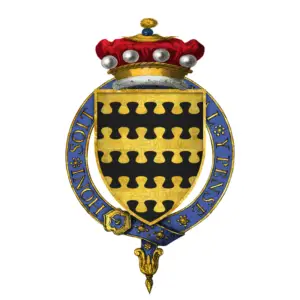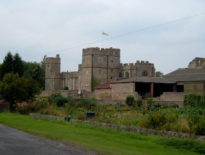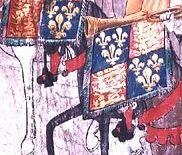 William Blount was one of the premier courtiers in Tudor England and was born in Barton Blount in around 1478 to John Mountjoy, the third Baron Mountjoy. John Mountjoy died in 1485, leaving William the title when he was still a young boy, thus his uncle Sir James Blount was granted custody of his lands and marriage. William himself, therefore, did not enter into his inheritance until 31st January 1500.
William Blount was one of the premier courtiers in Tudor England and was born in Barton Blount in around 1478 to John Mountjoy, the third Baron Mountjoy. John Mountjoy died in 1485, leaving William the title when he was still a young boy, thus his uncle Sir James Blount was granted custody of his lands and marriage. William himself, therefore, did not enter into his inheritance until 31st January 1500.
In 1497, Blount was involved in the suppression of the Cornish uprising by Perkin Warbeck, and during the same year, he married Elizabeth Say, and in 1498 he travelled to Paris. Here he met Erasmus, who became his tutor and referred to William as the 'most learned among nobles' and when Blount returned to England in 1499, Erasmus accompanied him. Following his return to England, Blount became tutor to Prince Henry, the future King Henry VIII, and introduced him to Thomas More and Erasmus and the work of the two men. Erasmus and Blount had a friendly relationship that lasted the majority of their lives, with the two men visiting each other frequently when time allowed.
William Blount soon became a popular and powerful figure at court, accompanying Henry VII to Calais in 1500, and witnessing the marriage of Katherine of Aragon and Prince Arthur. Blount enjoyed Henry VII's favour for some time and was a member of his council, and even visited by the king in 1508. In 1509 when Henry VIII came to the throne, Blount was present at his coronation and created a Knight of the Bath. On 9th July 1509, he was further favoured by being created master of the mint. As his first wife had died in 1506, in 1509, Blount married Inez de Venegas, one of Katherine of Aragon's attendants. On 6th October 1509, Blount was also appointed the lieutenant of the castle of Hammes near Calais.
In May 1512, Blount became Katherine of Aragon's chamberlain, and in 1513 he was present at the Spanish court. He was also put in command of transport for the war against France and departed for Calais with around 500 men. He was made lieutenant of Tournai after the capture of the city and, in 1515, was appointed as the governor of the city. Blount was eventually replaced as governor of Tournai in 1517 when he returned to England. During these years, although we don't know the exact date, Blount's second wife died, and in 1515 he re-married, taking Alice, daughter of Henry Keble, as his third wife. She accompanied Blount in 1520 to France and was present in the entourage of Katherine of Aragon during the Field of Cloth of Gold. In 1523, Blount accompanied Charles Brandon, Duke of Suffolk, on his invasion of France, and later that year, he married again, for a fourth time following the death of his third wife, Alice. He married a woman named Dorothy, daughter of the Marquess of Dorset. In 1526, Blount was still gaining increased favours at court, being elected a Knight of the Garter, and in 1529 he was elected as steward of Cambridge University.
As he was chamberlain to Katherine of Aragon, it fell to him to tell her the news that Henry VIII intended to divorce her, and in 1530 he signed the letter to Pope Clement VII in favour of the divorce. Despite his pubic support of the divorce – we don't know if he was in favour of it or just signed because he had to - he remained her chamberlain. In 1533, Eustace Chapuys wrote that Blount had been ordered to stay with Katherine to prevent her from escaping England, however, we don't know if this was true. Blount was also the head of the delegation that went to see Katherine at Ampthill to try to persuade her to submit to the king's marriage to Anne Boleyn and accept her new title as Princess Dowager. Katherine, however, refused.
After this failed attempt, Blount requested that he be relieved of the office of chamberlain, and in 1533 he wrote to Cromwell to that effect. In his letter, he stated that:
"hit is not my parte not for me this often to vexe of unquiet her whom the kynges grace xawsed to be sworne unto and truly to serve her to my power."
(State Papers, Henry VIII, 1.408)
His words suggest that he wasn't fond of the divorce nor how Katherine was being treated by Henry VIII. Following his resignation, he was not replaced in this office - unsurprisingly. In 1534, towards the end of his life, he was on the panel of lords that voted on the fate of the treason of William, Lord Dacre.
William Blount died on 8th November 1534 and was survived by his fourth wife. He was buried at Barton Blount in Derbyshire. He is remembered through history for his friendship with Erasmus, to whom we owe the vast majority of information about William Blount and his vast and intricate involvement in court life.
Blount's children included Gertrude Blount, who married Henry Courtenay, 1st Marquess of Exeter; Charles Blount, 5th Baron Mountjoy; Catherine Blount, who married John Champernowne and then Sir Maurice Berkeley; John Blount, Mary Blount, and Dorothy Blount.
Blount was the cousin of Elizabeth (Bessie) Blount, King Henry VIII's mistress.
by Georgia Whitehead
Georgia has just finished her masters in Classics at the University of Edinburgh. Academically, Georgia is interested in early Christianity, with her master's thesis focusing on "The Male Gaze and Self-Representation in Female Christian Narratives". In addition to her interest in ancient history, she has always been an avid lover of the Tudor era, drawn to the magnificence of the Tudor courts and the larger than life characters. She is particularly interested in The Reformation, Christianity and the shifting sands of ecclesiastical politics in this period and also has a keen interest in the lives of Tudor women. It is Georgia's ambition to become a writer, perhaps publishing her own Tudor novel one day.
Georgia also runs a history blog and instagram page called Historia Mundis.
Bibliography
- H. Miller, Henry VIII and the English nobility (1986), 18–19, 64, 82, 90, 94, 103–6, 111, 122, 136n., 146, 176–7, 183–4, 208.
- P. G. Bietenholz and T. B. Deutscher, eds., Contemporaries of Erasmus: a biographical register, 1 (1985), 154–6.
- State papers published under … Henry VIII, 11 vols. (1830–52), vol. 1.
- Carley, James P. (2004). "Blount, William, fourth Baron Mountjoy (c. 1478–1534)".



Leave a Reply